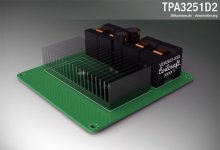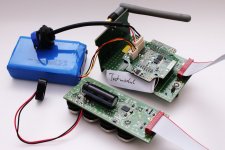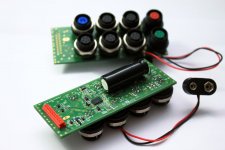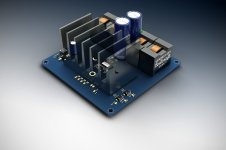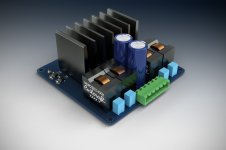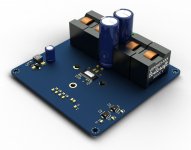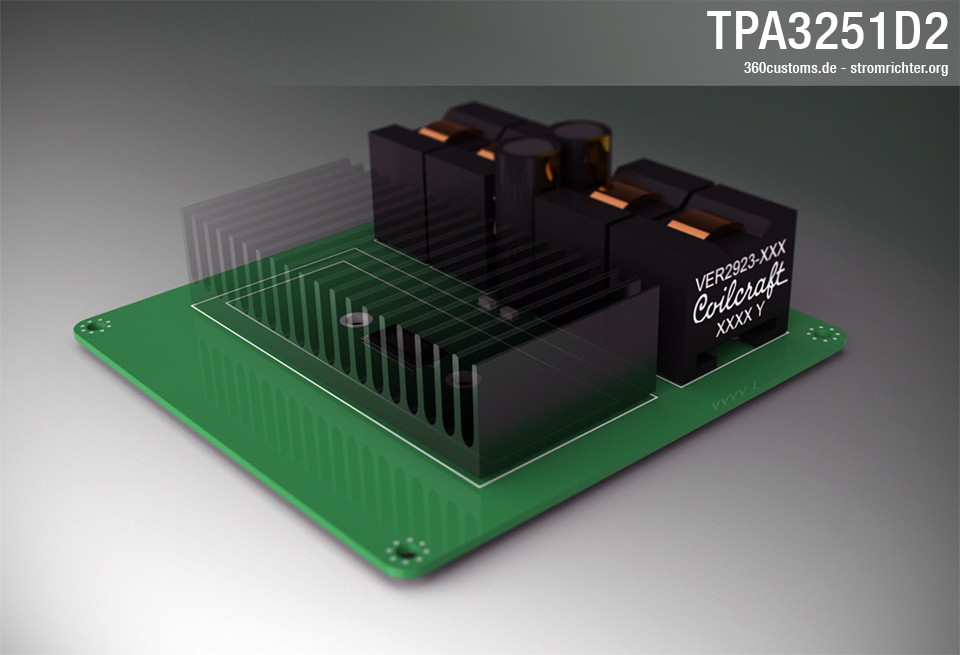
Needs some 3.5mm jack..
Good night.
Very nice locking mock up picture!
Any chance I can have a peek?I guess so, schematic is finished.
Needs some 3.5mm jack..
Good night.
Hi, why a 3.5 mm jack ? For headphones or, heaven forbid, for the inputs ? Worst connector since ages, alway bad contacts and crackling. I replaced so many of them that I never use them in my own designs.
edit: just checked your web page and it seems you use them for inputs. Bad choice compared to RCA. Sorry. Using RCA is standard and RCA to 3.5 mm cables can be bought. It would make your design way more user friendly, maybe you can use both ? With a power amp as this chip crackling seems to be very unwished for.
Last edited:
My card design is still in the planning stages.
I'm kicking a few ideas around, with the thoughts of making the card a bit more high end - I'll probably toss on a switching regulator to make +-12V out of PVCC, to power AVCC as well as a proper differential audio input stage.
I'm kicking a few ideas around, with the thoughts of making the card a bit more high end - I'll probably toss on a switching regulator to make +-12V out of PVCC, to power AVCC as well as a proper differential audio input stage.
Hi, why a 3.5 mm jack ?
Because i can.
Worst connector since ages, alway bad contacts and crackling. I replaced so many of them that I never use them in my own designs.
I never had any issues for the last 40 amp boards. So maybe yours where all from poor quality or not properly used/soldered. I use them always in a self grounding configuration to mute/ground the inputs when no connection is made.
edit: just checked your web page and it seems you use them for inputs. Bad choice compared to RCA. Sorry.
Well, even RCA is not GND before Signal when making a connection, so RCA is far from optimal as well. As my normal amp designs are made to be small and portable, i did not used RCA connectors mainly because of their size. Those amps are 50*50mm²..
It would make your design way more user friendly, maybe you can use both ? With a power amp as this chip crackling seems to be very unwished for.
If you will have a look again, you may notice that there's normally a pinheader for an alternative input.
Millions of millions of mobiles,mp3-players etc. worldwide get stressed/stretched/used every day with lots of force on the 3.5mm connectors. Quality ones wont fail, cheap ones will.
But in the end, there will be RCA (at least) on this board.
Beside this, do you prefer an opamp differential input stage or a PNP differential amp with constant current?
Well, even RCA is not GND before Signal when making a connection, so RCA is far from optimal as well. As my normal amp designs are made to be small and portable, i did not used RCA connectors mainly because of their size. Those amps are 50*50mm²..
Millions of millions of mobiles,mp3-players etc. worldwide get stressed/stretched/used every day with lots of force on the 3.5mm connectors. Quality ones wont fail, cheap ones will.
GND before signal has not been the primary goal of RCA and who plugs in connectors on a live power amp ?
I have used many different 3.5 mm jacks and if the connector does not fail then the cable will. Also in mobile phones it is one of the most failing connectors with micro USB as a good second one. These connectors were not designed for high quality but for low cost. Talk to a repairman (I was one myself) and I know what answer you'll get
Just joking, I understand you only want portable stuff and thus you do some concessions but TPA3251D2 won't be for portable designs I guess.
Last edited:
I'd actually argue that 3.5mm connectors are just as reliable as RCA jacks, if not more so. However 3.5mm jacks end up being subjected to far more mechanical cycling just because of the application they end up being used in (headphone jacks on MP3 players) which is why you see many more of them go bad.I am not an advocate for RCA but when do you see an RCA plug/jack fail ?
In a fixed amplifier like doctormord's, the jack might only get plugged/unplugged a few dozen times over the lifetime of the amplifier. Assuming a good quality jack is used, and the customer plugs in a good quality plug, it'll be fine.
GND before signal has not been the primary goal of RCA and who plugs in connectors on a live power amp ?
Oh well, alot of people who don't know better.
I have used many different 3.5 mm jacks and if the connector does not fail then the cable will. Also in mobile phones it is one of the most failing connectors with micro USB as a good second one. These connectors were not designed for high quality but for low cost.
I thought micro USB where designed to be small, not especially for being low cost.
Talk to a repairman (I was one myself) and I know what answer you'll getThe quality ones just last a bit longer. I am not an advocate for RCA but when do you see an RCA plug/jack fail ?
Not that often, but, as stated, i'm not seeing a "3o5" fail that often.
Of course you can use 3.5 mm "because you can". You can also design 50 x 50 mm2 boards to keep costs low but isn't this hobby meant to get the best out of a design ?
Sure, but does size matters? Or do bigger design usually perform better? I.e. there are alot chinese TPA3116 boards out there, which are bigger and perform worse.
Since when is very small size obligatory ? To be able to use 3.5 mm connectors and leave out the coils ?
To me, its obligatory as the most things i do at my job/study are small and even alot smaller than those amps.
Beside this, leaving the coils off is not usually a bad thing if you can make sure noone gets "hurt" (EMV/EMI whise).
Just joking, I understand you only want portable stuff and thus you do some concessions but TPA3251D2 won't be for portable designs I guess.
Because noone did it right now. There are ppl who use 300/600W TAS amps on their bikes. To me, a 100x100mm² board is "huge".
So lets see, what there will be in the end.
Regards,
doc
Last edited:
I'd actually argue that 3.5mm connectors are just as reliable as RCA jacks, if not more so. However 3.5mm jacks end up being subjected to far more mechanical cycling just because of the application they end up being used in (headphone jacks on MP3 players) which is why you see many more of them go bad.
In a fixed amplifier like doctormord's, the jack might only get plugged/unplugged a few dozen times over the lifetime of the amplifier. Assuming a good quality jack is used, and the customer plugs in a good quality plug, it'll be fine.
They are made to be cycled often by design and they have switches inside so moving parts and we know what happens to moving parts. They are used for portable stuff as they are small and cheap. The are definitely NOT more reliable than RCA connectors. No manufacturer burns his fingers on them in normal consumer HiFi equipment. But after having seen RCA being used for SPDIF as a standard and for example the older Iphone connector nothing surprises me anymore, so let the 3.5 mm plug be the new standard in HiFi
Now I will retreat and plug in my headphones (6.3 mm jack....).
Last edited:
Offtopic:
I like/use the Binder 620/720 series alot, even if they are made of plastic.
Snap-in connectors IP 67 - Franz Binder GmbH & Co. Elektrische Bauelemente KG
(As seen on the pictures from another project)
Attachments
This is KiCAD VRML export with custom 3d-models in a HDR renderer + some postprocessing in Photoshop.
Btw.
Beside those Coilcraft wirewound inductors here:
http://www.mouser.ee/ProductDetail/Coilcraft/MA5172-AE/?qs=ZYnrCdKdyedMvVvFAobk3w==
What do you think about those:
http://www.mouser.ee/ProductDetail/...GAEpiMZZMsg%2by3WlYCkU4PzPTkpdogh7gwLG/FOMSk=
and especially these:
http://www.mouser.ee/ProductDetail/...EpiMZZMsg%2by3WlYCkU3WuiCT54zcgYN7U25CV%2bGU=
Btw.
Beside those Coilcraft wirewound inductors here:
http://www.mouser.ee/ProductDetail/Coilcraft/MA5172-AE/?qs=ZYnrCdKdyedMvVvFAobk3w==
What do you think about those:
http://www.mouser.ee/ProductDetail/...GAEpiMZZMsg%2by3WlYCkU4PzPTkpdogh7gwLG/FOMSk=
and especially these:
http://www.mouser.ee/ProductDetail/...EpiMZZMsg%2by3WlYCkU3WuiCT54zcgYN7U25CV%2bGU=
Last edited:
Nice. I've tried learning KiCAD on a few occasions but ultimately the requirement to get things done puts me back into using Eagle.
The L versus I curve has a slope on both of those inductors, which will cause L to change with the audio waveform, I'm not too fond of that since there's no post filter feedback on the TPA. The Coilcraft toroid and the VER2923 have a flat L value up until the point of saturation, I greatly prefer that.
The L versus I curve has a slope on both of those inductors, which will cause L to change with the audio waveform, I'm not too fond of that since there's no post filter feedback on the TPA. The Coilcraft toroid and the VER2923 have a flat L value up until the point of saturation, I greatly prefer that.
- Home
- Amplifiers
- Class D
- TPA3251d2
